Swallowtail butterfly
| Swallowtail butterfly | ||||||||||||||
|---|---|---|---|---|---|---|---|---|---|---|---|---|---|---|
Western Tiger Swallowtail, Papilio rutulus
|
||||||||||||||
| Scientific classification | ||||||||||||||
|
||||||||||||||
| Type species | ||||||||||||||
| Papilio machaon (Old World Swallowtail) |
||||||||||||||
| Subfamilies and genera | ||||||||||||||
|
There are 26 genera and about 605 species:
|
Swallowtail butterflies are large, colorful butterflies which form the family Papilionidae. There are at least 550 species, and though the majority are tropical, members of the family are found on all continents except Antarctica. The family includes the largest butterflies in the world, the birdwing butterflies of Australia (genus Ornithoptera).[1]
Swallowtails differ from all other butterflies in a number of anatomical traits. Most notably, their caterpillars possess a unique organ behind their heads, called the osmeterium. Normally hidden, this forked structure can be everted when the caterpillar is threatened, and emits smelly secretions containing terpenes. The adults are often tailed like the forked tail of some swallows, giving the insect its name.
Contents |
Classification
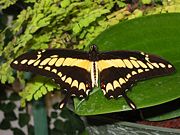
The genera of extant swallowtails are usually classified into three subfamilies, Baroniinae, Parnassiinae and Papilioninae, the latter two being further divided into tribes. The tribes recognized are Baroniini, Parnassiini, Zerynthiini, Luehdorfiini, Leptocircinini, Teinopalpini, Troidiini and Papilioniini. An additional subfamily Praepapilioninae, has a single extinct member, and is known only from a single fossil.[2] A proposed phylogeny of the Papilionidae is given below:[3]
|
||||||||||||||||||||||||||||||||||
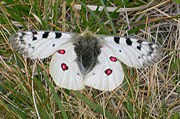
The Swallowtail butterflies in the tribe Papilionini number about 225 species and studied have been made on their host-plant coevolution and phylogeny. A study found that the Papilios are monophyletic and old morphological classifications where also found to be valid in that they formed clusters. Species belonging to the groups that use Rutaceae as host plants formed two groups corresponding to Old World and American taxa. Those that fed on Lauraceae and Magnoliaceae were found to form another cluster which includes both Asian and American taxa.[4]
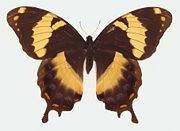
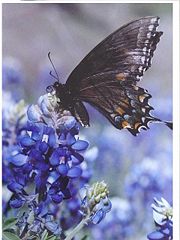
Swallowtail tribes Zerynthiini (Parnassiinae), Luehdorfiini (Parnassiinae) and Troidini (Papilioninae) almost exclusively use the Aristolochiaceae family as their host plants. Many species sequester aristolochic acids making them unpalatable, causing both the larval and adult stages to be unpalatable to predators.[5]
The subfamily Baroniinae is represented by the sole representative species Baronia brevicornis. They are unique in the family to use the Fabaceae as their larval host plants.
The Apollos, Parnassiinae, are a distinctive group and all species are alpine and capable of living at high altitudes. Most species have two small reddish spots on their hindwings. The genera Parnassius and Hypermnestra were found to be extremely close based on molecular studies.[6] After mating, the male Parnassines produce a glue like substance that is used to seal the female genital opening and prevent other males from mating.
The pupae are typically attached to the substrate attached by the cremaster but with head up held by a silk girdle. The apollos however pupate in debris on the ground and also build a loose cocoon. In the temperate regions the winters are passed in a pupal diapause stage.
Swallowtails and Humans
Swallowtail butterflies, being large, colourful, and attractive, have been the target of butterfly collectors in earlier times. The largest of these, the Birdwing butterflies are particularly sought after and are cultured in butterfly farms for the purpose of collectors.
Many members of the family feed as larvae on plants of the Citrus family Rutaceae. Some of these attractive butterflies are therefore considered pests in Citrus orchards.
The Oregon Swallowtail Butterfly is the state insect of Oregon; the eastern tiger swallowtail is the state insect of Virginia, Alabama, South Carolina and Delaware. (See List of U.S. state butterflies)
The Tiger Swallowtail is the state butterfly of Georgia.
Notable species
- Anise swallowtail, Papilio zelicaon
- Black swallowtail, Papilio polyxenes
- Clouded apollo, Parnassius mnemosyne
- Eastern tiger swallowtail, Papilio glaucus
- Pipevine swallowtail, Battus philenor
- Scarce swallowtail, Iphiclides podalirius
- Spicebush swallowtail, Papilio troilus
- Western Tiger swallowtail, Papilio rutulus
- Old World Swallowtail, Papilio machaon
- Citrus swallowtail, Papilio demodocus
- Apollo butterfly, Parnasius apollo
- Zebra Swallowtail, Eurytides marcellus
Notable species in Japan
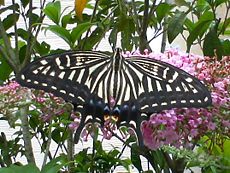
- Asian Swallowtail, Papilio xuthus Linnaeus, 1767. Most Japanese recognize this species as common swallowtail.
- Old World Swallowtail, Papilio machaon Linnaeus, 1758.
- Red Helen, Papilio helenus Linnaeus, 1758.
- Spangle, Papilio protenor Cramer, 1775.
- Chinese Peacock, Papilio bianor Cramer, 1777.
- Papilio maackii Ménétries, 1859.
- Great Mormon, Papilio memnon, Linnaeus, 1758.
- Atrophaneura alcinous/Byasa alcinous Klug, 1836.
- Common bluebottle,Graphium sarpedon Linnaeus, 1758.
In Fiction
In the 1996 Season of the popular Japanese Metal Heroes series "B-Fighter Kabuto" and the 1997 American show "Beetleborgs Metallix", one of the B-fighters/Astral Borgs motifs was a Swallowtail Butterfly hence her Japanese designated name "B-Fighter Ageha". Though her insect designation was never announced in Beetleborgs Metallix (her name being Ladyborg), the astral coin that was used to summon her has the illustration of a Swallowtail Butterfly.
References
- ↑ Reed, Robert D. and Sperling, Felix A. H. 2006. Papilionidae. The Swallowtail Butterflies. Version 7 July 2006. [1] in The Tree of Life Web Project, [2]
- ↑ Durden, C.J., and H. Rose. 1978. Butterflies from the middle Eocene: the earliest occurrence of fossil Papilionidae (Lepidoptera). Pearce-Sellards Ser. Tex. Mem. Mus. 29: 1-25.
- ↑ Reed, Robert D. and Sperling, Felix A. H. 2006. Papilionidae. The Swallowtail Butterflies. Version 7 July 2006. [3] in The Tree of Life Web Project, [4]
- ↑ Aubert J, Legal L, Descimon H, Michel F. 1999 Molecular phylogeny of swallowtail butterflies of the tribe Papilionini (Papilionidae, Lepidoptera). Mol Phylogenet Evol.12(2):156-67
- ↑ von Euw, J., T. Reichstein, and M. Rothschild. 1968. Aristolochic acid in the swallowtail butterfly Pachlioptera aristolochiae. Isr. J. Chem. 6: 659-670.
- ↑ Katoh T, Chichvarkhin A, Yagi T, Omoto K. 2005 Phylogeny and evolution of butterflies of the genus Parnassius: inferences from mitochondrial 16S and ND1 sequences. Zoolog Sci.22(3):343-51
External links
- Tree of Life Papilionidae
- revised GloBIS/GART species checklist
- Swallowtail photos
- Afrotropical Kite Swallowtails
- BBC News: "LEDs work like butterflies' wings"
on the UF / IFAS Featured Creatures Web site
- Eurytides marcellus, zebra swallowtail
- Papilio aristodemus ponceanus, Schaus swallowtail
- Papilio glaucus, tiger swallowtail
- Papilio palamedes, palamedes swallowtail
|
|||||||||||||||||||||||||||||||